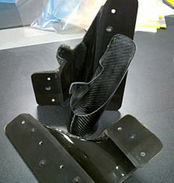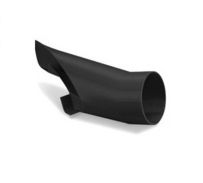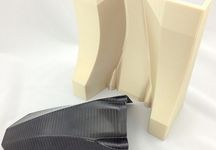- Commercial 3D printers & additive manufacturing solutions
- Order sample print
- 3D Printers
-
Industries
-
3D Printers for Architects
3D printers for BIM, Architecture & AEC
- Objet30 Pro 3D Printer
-
Automotive
- ABS-like
- Fortus 380 Carbon Fiber
- High Temperature
- Nylon 12
- Objet Eden500V
- Objet1000 3D Printer
- Objet30 Pro 3D Printer
- Objet350 Connex
- Stratasys Dimension 1200es Series
- Stratasys Fortus 250mc
- Stratasys Fortus 360mc
- Stratasys Fortus 900mc
- Stratasys Mojo 3D Printer
-
Consumer Electronics
- ABS-ESD7 - static dissipative properties
- ABS-like
- High Temperature
- Nylon 12
- Objet Eden500V
- Objet30 Pro 3D Printer
- Objet350 Connex
- Rigid Opaque
- Rubber-like
- Stratasys Fortus 250mc
-
Consumer Goods
- Nylon 12
- Objet Eden500V
- Objet30 Pro 3D Printer
- Objet350 Connex
- Polypropylene-like
- Rigid Opaque
- Rubber-like
- Stratasys Fortus 250mc
- Stratasys Fortus 900mc
- Stratasys J55
- Stratasys Mojo 3D Printer
-
Aerospace & Defence
- ABS-ESD7 - static dissipative properties
- Objet Eden500V
- Objet1000 3D Printer
- Objet30 Pro 3D Printer
- Objet350 Connex
- Stratasys Dimension 1200es Series
- Stratasys Dimension Elite 3D Printer
- Stratasys Fortus 250mc
- Stratasys Fortus 360mc
- Stratasys Fortus 900mc
-
Dental
- Bio-Compatible
- Dental Materials
- Objet Eden260V Dental Advantage
- Objet350 Connex
- Transparent
-
Education
- Educators
- Researchers
- Students
- MakerBot Method
- Objet Eden500V
- Objet1000 3D Printer
- Objet350 Connex
- Stratasys Dimension 1200es Series
- Stratasys Dimension Elite 3D Printer
- Stratasys Fortus 250mc
- Stratasys Fortus 360mc
- Stratasys Fortus 900mc
- Stratasys Mojo 3D Printer
-
Entertainment
- Objet1000 3D Printer
- Stratasys Fortus 250mc
- Stratasys Fortus 900mc
- Stratasys Mojo 3D Printer
-
Hearing Aids
- Dental Materials
- Hearing Aids
- Objet350 Connex
- Transparent
-
Industrial Machinery
- Desktop Metal Studio System 3D Printer
- High Temperature
- Nylon 12
- Objet Eden500V
- Objet1000 3D Printer
- Objet30 Pro 3D Printer
- Objet350 Connex
- Stratasys Dimension 1200es Series
- Stratasys Fortus 250mc
- Stratasys Fortus 360mc
- Stratasys Fortus 900mc
-
Jewellery
-
Medical
- Dental Materials
- Nylon 12
- Objet Eden500V
- Objet350 Connex
- Transparent
-
Medical Equipment
- Nylon 12
- Objet1000 3D Printer
- Objet350 Connex
- Polypropylene-like
- Stratasys Dimension 1200es Series
- Stratasys Fortus 250mc
- Stratasys Fortus 360mc
- Stratasys Fortus 900mc
-
Packaging
- Polypropylene-like
- Transparent
-
Service Bureaus
- Nylon 12
- Objet Eden500V
- Objet1000 3D Printer
- Objet30 Pro 3D Printer
- Stratasys Fortus 360mc
-
Sporting Goods
- Polypropylene-like
- Stratasys Mojo 3D Printer
-
Toys
- Rigid Opaque
- Rubber-like
- Stratasys Fortus 250mc
-
-
Brand
-
Desktop Metal
- Desktop Metal Studio System 3D Printer
-
Stratasys
Our Stratasys range
- 3D Printing for Direct Digital Manufacturing
- ABS-ESD7 - static dissipative properties
- ASA Thermoplastic
- Dental Materials
- Digital Materials | 3D Materials
- Fortus 380 Carbon Fiber
- Hearing Aids
- Nylon 12
- Objet Eden250
- Objet Eden260V
- Objet Eden260V Dental Advantage
- Objet Eden260VS
- Objet Eden350V
- Objet Eden500V
- Objet Water Jet Support Material removal System
- Objet1000 3D Printer
- Objet260 Connex
- Objet260 CONNEX1 3D Printer
- Objet260 CONNEX2 3D Printer
- Objet30 Prime 3D Printer
- Objet30 Pro 3D Printer
- Objet350 Connex
- Objet500 Connex 3D Printer
- Objet500 Connex1
- Objet500 Connex2
- Objet500 Connex3 3D Printer
- Stratasys Dimension 1200es Series
- Stratasys Dimension Elite 3D Printer
- Stratasys Dimension SCA-1200 Support Removal System
- Stratasys F170 3D Printer
- Stratasys F270 3D Printer
- Stratasys F370 3D Printer 3D Printer
- Stratasys Fortus 250mc
- Stratasys Fortus 360mc
- Stratasys Fortus 380mc Production 3D Printer
- Stratasys Fortus 400mc 3D Printer
- Stratasys Fortus 450mc Production 3D Printer
- Stratasys Fortus 900mc
- Stratasys J55
- Stratasys J850
- Stratasys Mojo 3D Printer
- Stratasys uPrint SE 3D Printer
- Stratasys uPrint SE Plus 3D Printer
- Stratasys Wavewash 55
- ULTEM 1010
-
Makerbot
Our Makerbot range
- MakerBot Method
- Makerbot Replicator Mini
- Makerbot Replicator Z18 3D Printer
-
Autodesk
Our Autodesk products
- AutoCAD Inventor LT Suite
- Autodesk 3D Max
- Autodesk Inventor
-
- Materials
- Accessories
- Software
- Applications
-

Applications
- 3D Printed Jigs and Fixtures
- 3D Printing for Direct Digital Manufacturing
- Blow Moulding With 3D Printers
- Carbon Fibre Layup with 3d Printer
- Injection Moulds with a 3D Printer
- Investment Casting with a 3D Printer
- Metal Hydroforming with a 3D Printer
- Sand Casting With 3D Printers
- Simulated Overmolding with 3D Printer
- Soluble Cores with a 3D Printer
- Thermoforming With PolyJet or FDM 3D Printer
Soluble Cores with a 3D Printer
FDM soluble support material holds much more value than just being a support material for a 3d building process. Stratasys Fortus Production FDM 3D Printers can be utilised with just the soluble support itself, the model material can be changed to support material, leading to a host of new and unique applications—most popular are soluble cores for composite parts.Application Outline
Composite parts are manufactured by winding, wrapping, molding and laying up various combinations of materials and resin systems on molds, bucks, patterns, cores and mandrels. Producing hollow composite parts that trap the pattern can present a manufacturing challenge.
This new approach provides substantial improvements for low–volume production by replacing the mold with an FDM soluble core. Soluble cores substantially reduce delivery lead time and labour expenses by eliminating the need for making a mold and also reducing the time required for laying up the part. Instead of the tedious process of laying up the two mold halves, then laying up the part in each half, and then bonding the two halves together, the composite cloth can be wrapped around the soluble core. After the part has cured, the core is simply dissolved using a supplied dishwasher component.
The nature of additive manufacturing makes it possible for FDM to produce much more complex geometries than are possible with other cores. In many applications, greater design freedom generates performance improvements and cost reductions. FDM soluble cores are strong enough to withstand the loads of composite manufacturing processes and there is no risk of damaging the part during core extraction because the core simply melts away as it soaks in a liquid bath.
Process Overview
Manufacturing FDM soluble cores requires two changes to the standard FDM process. First, the core is designed to make its internal structure mostly hollow. Second, the strong thermoplastic of a standard FDM part is replaced with a soluble material that is normally used for the construction of a part’s support structures. The core can be designed in two different ways. One way is to create a solid 3D model and use the sparse fill option, while in Insight — the Fortus build prepartion software — to automatically create an internal structure that minimizes the internal volume of the core. The second approach is to create (in CAD) an internal structure that keeps the core stable under the temperatures and pressures of composite molding while promoting flow of the solution to accelerate core removal. Both of these approaches minimize material consumption, build time and washout time.
It’s relatively simple to integrate FDM soluble cores into the manufacturing process. No modifications to the process are needed prior to composite curing and core removal. The cure cycle is also unchanged, but temperatures must be limited to avoid distortion. In general, composite parts with FDM cores must be cured at temperatures below 250 °F (121 °C) and at pressures less than 50 psi (345 kPa). The only process change is that, after the composite part has cured, the core is removed by dissolving it in a solution bath. To do so, the part is placed in the Stratasys WaterWorks soluble support system.
Customers who were interested in this product also viewed
-
More information
Carbon Fibre Layup with 3d Printer
Fibre–reinforced plastics are a group of composite materials consisting of a polymer matrix reinforced with fibers, that when combined together form a new material with physical properties exceeding those of either constituent material.
 Worcester (Head Office) 01905 458 000
Worcester (Head Office) 01905 458 000 3d@stanfordmarsh.co.uk
3d@stanfordmarsh.co.uk












